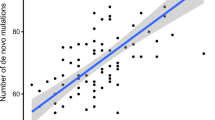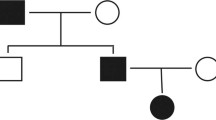Abstract
Bipolar disorder (BD) is a severe psychiatric disorder characterized by the recurrence of depressive and manic episodes. Its heritability is high, and many linkage and association studies have been performed. Although various linkage regions and candidate genes have been reported, few have shown sufficient reproducibility, and none have identified the pathogenic genes based on the results of the linkage analysis. To find functional variants that are expected to be rare and have strong genetic effects, we recruited ten healthy individuals, two individuals with unknown status, and six patients with BD or recurrent major depressive disorder (MDD) from a Japanese family consisting of 21 members. We performed a genome-wide linkage analysis using a 100K single-nucleotide polymorphism (SNP) array and microsatellite markers to narrow linkage regions within this family. Subsequently, we performed whole-exome sequencing for two patients with BD to identify genetic mutations in the narrowed linkage regions. Then, we performed co-segregation analysis for DNA variants obtained from the results of the exome sequencing. Finally, we identified a rare heterozygous mutation in exon 31 of DOCK5 (c.3170A>G, p.E1057G). Convergent functional genomics analysis revealed that DOCK5 was listed as one of the biomarkers for mood state and suicidality. Although DOCK5 is still a functionally unknown gene, our findings highlight the possibility of a pathological relationship between BD and DOCK5.
This is a preview of subscription content, access via your institution
Access options
Subscribe to this journal
Receive 12 print issues and online access
$259.00 per year
only $21.58 per issue
Buy this article
- Purchase on Springer Link
- Instant access to full article PDF
Prices may be subject to local taxes which are calculated during checkout




Similar content being viewed by others
Change history
17 February 2021
A Correction to this paper has been published: https://doi.org/10.1038/s10038-020-00856-z
References
Merikangas KR, Jin R, He J-P, Kessler RC, Lee S.Sampson NA, et al. National Institute of Mental Health, Genetic Epidemiology Research Branch, Building 35, Room 1A201, 35 Conv Drive. 2011;3720:241–51. www.hcp.med.harvard.edu/wmh/.
Ishikawa H, Kawakami N, Kessler RC. Lifetime and 12-month prevalence, severity and unmet need for treatment of common mental disorders in Japan: results from the final dataset of World Mental Health Japan Survey. Epidemiol Psychiatr Sci. 2016;25:217–29.
Barnett JH, Smoller JW. The genetics of bipolar disorder. Neuroscience. 2009;164:331–43.
Edvardsen J, Torgersen S, Røysamb E, Lygren S, Skre I, Onstad S, et al. Heritability of bipolar spectrum disorders. Unity or heterogeneity? J Affect Disord. 2008;106:229–40.
Barnett JH, Smoller JW. The genetics of bipolar disorder. Neuroscience. 2009;164:331–43.
Lee SH, Wray NR, Goddard ME, Visscher PM. Estimating missing heritability for disease from genome-wide association studies. Am J Hum Genet. 2011;88:294–305.
Collins AL, Kim Y, Szatkiewicz JP, Bloom RJ, Hilliard CE, Quackenbush CR, et al. Identifying bipolar disorder susceptibility loci in a densely affected pedigree. Mol Psychiatry. 2013;18:1245–6.
Kong A, Gudbjartsson DF, Sainz J, Jonsdottir GM, Gudjonsson SA, Richardsson B, et al. A high-resolution recombination map of the human genome. Nat Genet. 2002;31:241–7.
Flanagan SE, Patch AM, Ellard S. Using SIFT and PolyPhen to predict loss-of-function and gain-of-function mutations. Genet Test Mol Biomar. 2010;14:533–7.
Duarte AJ, Ribeiro D, Moreira L, Amaral O. In silico analysis of missense mutations as a first step in functional studies: examples from two sphingolipidoses. Int J Mol Sci. 2018;19:3409.
Stahl EA, Breen G, Forstner AJ, McQuillin A, Ripke S, Trubetskoy V, et al. Genome-wide association study identifies 30 loci associated with bipolar disorder. Nat Genet. 2019;51:793–803.
Park N, Juo SH, Cheng R, Liu J, Loth JE, Lilliston B, et al. Linkage analysis of psychosis in bipolar pedigrees suggests novel putative loci for bipolar disorder and shared susceptibility with schipzoprenia. Mol Psychiatry. 2004;9:1091–9.
Ganesh S, Ahmed PH, Nadella RK, More RP, Seshadri M, Viswanath B, et al. Exome sequencing in families with severe mental illness identifies novel and rare variants in genes implicated in Mendelian neuropsychiatric syndromes. Psychiatry Clin Neurosci. 2019;73:11–9.
Le-Niculescu H, Kurian SM, Yehyawi N, Dike C, Patel SD, Edenberg HJ, et al. Identifying blood biomarkers for mood disorders using convergent functional genomics. Mol Psychiatry. 2009;14:156–74.
Côté JF, Vuori K. Identification of an evolutionary conserved superfamily of DOCK180-related proteins with guanine nucleotide exchange activity. J Cell Sci. 2002;115:4901–13.
Shi L. Dock protein family in brain development and neurological diseasee. Commun Integr Biol. 2013;6:1–9.
Cimino PJ, Yang Y, Li X, Hemingway JF, Cherne MK, Khademi SB, et al. Ablation of the microglial protein DOCK2 reduces amyloid burden in a mouse model of Alzheimer’s disease. Exp Mol Pathol. 2013;94:366–71.
Kato TA, Watabe M, Kanba S. Neuron-glia interaction as a possible glue to translate the mind-brain gap: a novel multi-dimensional approach toward psychology and psychiatry. Front Psychiatry. 2013;4:1–7.
Ogawa K, Tanaka Y, Uruno T, Duan X, Harada Y, Sanematsu F, et al. DOCK5 functions as a key signaling adaptor that links FcεRI signals to microtubule dynamics during mast cell degranulation. J Exp Med. 2014;211:1407–19.
Hou L, Heilbronner U, Degenhardt F, Adli M, Akiyama K, Akula N, et al. Genetic Variants associated with response to lithim treatment. Lancet. 2016;387:1085–93.
Acknowledgements
The authors thank all involved patients and their families for their participation. The authors also thank Ms. Hiwatashi, Ms. Yokoyama, and Ms. Meguro for their technical assistance. We would like to thank Uni-edit (https://uni-edit.net/) for editing and proofreading this manuscript.
Author information
Authors and Affiliations
Corresponding author
Ethics declarations
Conflict of interest
The authors declare that they have no conflict of interest.
Additional information
Publisher’s note Springer Nature remains neutral with regard to jurisdictional claims in published maps and institutional affiliations.
Supplementary information
Rights and permissions
About this article
Cite this article
Umehara, H., Nakamura, M., Nagai, M. et al. Positional cloning and comprehensive mutation analysis of a Japanese family with lithium-responsive bipolar disorder identifies a novel DOCK5 mutation. J Hum Genet 66, 243–249 (2021). https://doi.org/10.1038/s10038-020-00840-7
Received:
Revised:
Accepted:
Published:
Issue Date:
DOI: https://doi.org/10.1038/s10038-020-00840-7



